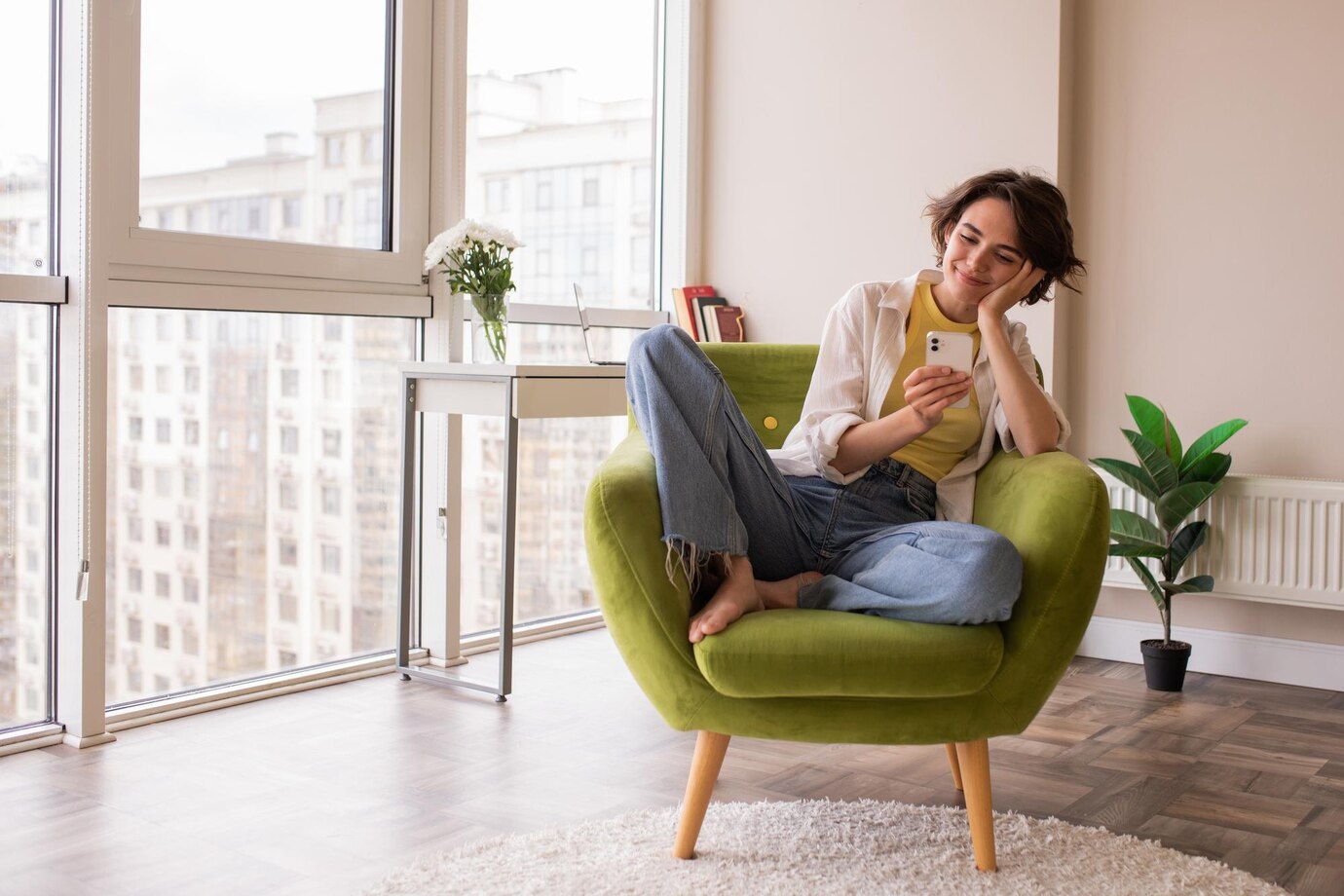

Table of Contents
ToggleHave you ever walked into a home and felt an instant sense of warmth, ease, and comfort, like you could kick off your shoes and relax without a second thought? And yet, in other homes, something just feels off. Maybe the space seems too cold, too cluttered, or simply uninviting. This isn’t just a coincidence. The way a home makes you feel is a direct result of intentional design choices beyond aesthetics.
A truly comfortable home design is more than just beautiful furniture and stylish decor; it’s about creating a space that welcomes you in, puts you at ease, and enhances your overall well-being. From the way natural light filters into a room to the textures under your fingertips, every small detail contributes to how a home feels.
It’s not just about what looks good; it’s about what feels good. The colors on the walls, the placement of furniture, the scent in the air, and even the amount of open space versus coziness- all these elements come together to create an environment that’s either warm and inviting or cold and impersonal. A home should be a sanctuary, a place where you feel truly yourself, and achieving this level of comfort requires thoughtful planning.
Lighting is one of the most powerful tools in home design, yet it’s often overlooked. It can completely transform a space, influencing not just how it looks but how it feels. Walk into a home bathed in soft, warm lighting, and you’ll immediately feel at ease. On the other hand, a room with harsh, bright lighting can feel sterile, cold, and even stressful. The key to making a home feel comfortable is to create an atmosphere that mimics the warmth of natural light, allowing your space to feel cozy and inviting at any time of the day.
To achieve this, start by selecting the right lightbulbs. Instead of cool-toned or daylight bulbs, opt for warm white LED bulbs (2700K -3000 K), which emit a soft, golden glow reminiscent of a sunset. This type of lighting instantly makes a room feel more welcoming and soothing, perfect for relaxation. Additionally, layering different light sources throughout your home creates depth and warmth. Rather than relying solely on a harsh overhead ceiling light, incorporate table lamps, floor lamps, pendant lights, and wall sconces. This approach diffuses the light, preventing any one source from feeling overpowering.
Another great way to enhance the coziness of a space is by adding dimmers. The ability to adjust brightness according to the time of day and your mood allows for a more dynamic and comforting atmosphere. In the evening, dimmed lights can create a calming ambiance that signals relaxation, helping you unwind after a long day.
The colors in a home have a profound effect on the way it feels. They can create warmth, evoke calmness, and even influence emotions. If you’ve ever walked into a room and felt immediately at peace, chances are the color palette played a significant role. Certain hues have a natural ability to make a space feel cozy and inviting, while others can make it feel cold, stark, or overwhelming.
For a home that radiates comfort, opt for warm neutrals, such as beige, ivory, taupe, and warm grays. These colors provide a soft and soothing backdrop that makes a room feel grounded and harmonious. They also work well with almost any decor style, making them an easy choice for creating a timeless, inviting space.
Earthy tones like soft greens, terracotta, and warm browns bring a sense of nature indoors, fostering a grounded, tranquil environment. These colors mimic the hues found in the natural world, making them incredibly comforting to the human eye. A soft sage green or a muted clay tone, for example, can make a space feel serene and connected to nature.
For bedrooms or relaxation areas, muted pastels such as soft blues, blush pinks, and lavender tones work wonderfully. These shades are known for their calming properties and can help lower stress levels, making them ideal for spaces meant for rest.
While bright whites might seem like a clean and modern choice, they can often make a home feel too clinical or impersonal. Instead, opt for warm undertones in your whites and neutrals to maintain a sense of coziness. Even a subtle cream or off-white can make a significant difference in softening a room’s atmosphere.
Additionally, the type of furniture you choose impacts the overall vibe of the room. Soft, plush seating with rounded edges naturally feels more inviting than sleek, modern designs with sharp corners. Oversized armchairs, cushioned sofas, and deep-seated sectionals all add to the feeling of relaxation and coziness.
A truly inviting home isn’t just about how it looks; it’s also about how it feels. The sense of touch plays a huge role in comfort, and incorporating a variety of textures throughout your space can make a world of difference. A home that feels too smooth, rigid, or uniform can come across as impersonal, while a well-balanced mix of soft, plush, and natural materials creates a space that feels layered, warm, and cozy.
One of the easiest ways to introduce texture into your home is through soft blankets and throws. A chunky knit throw draped over a sofa or a plush blanket folded at the foot of a bed not only adds visual interest but also invites people to wrap themselves up and get comfortable. Plush area rugs are another game-changer; a soft, high-pile rug instantly makes a room feel warmer and more inviting.
Curtains also contribute to the overall texture of a space. While bare windows or harsh blinds can make a home feel cold, adding velvet, linen, or heavy cotton drapes softens the look and enhances the sense of coziness. These materials filter light beautifully, adding a warm, diffused glow to your space.
Another essential element in cozy design is the use of natural materials like wood and stone. Wood, whether in the form of flooring, furniture, or decorative accents, adds warmth and depth to a room. The grain patterns and organic textures create a grounded, earthy atmosphere that makes a home feel more inviting. Similarly, exposed brick, textured stone, or even woven baskets introduce natural elements that contribute to a relaxed, comforting ambiance.
The scent of a home plays a vital role in shaping its atmosphere, influencing emotions, and creating a sense of comfort. A fresh, inviting fragrance can instantly make a space feel warm and welcoming, while unpleasant odors can disrupt the ambiance.

Scents like lavender and chamomile promote relaxation, making them perfect for bedrooms and cozy corners. Citrus blends, such as orange and lemon, bring an uplifting energy, ideal for kitchens and living areas. Earthy aromas like cedar and sandalwood add warmth, while vanilla and cinnamon evoke nostalgia and a sense of home.
Incorporating these fragrances through essential oil diffusers, scented candles, or fresh flowers enhances the overall experience. Proper ventilation and regular cleaning also help maintain a pleasant aroma, ensuring the space remains fresh and inviting. Thoughtfully chosen scents contribute to a well-designed home, making it not only visually appealing but also emotionally comforting.
A house becomes a home when it reflects the personality and warmth of the people living in it. Adding personal touches brings character to a space, making it feel inviting and meaningful. Displaying family photos, cherished artwork, or travel souvenirs creates a sense of nostalgia and connection. Bookshelves filled with favorite reads add warmth and encourage a cozy atmosphere. Handcrafted or DIY decor items bring uniqueness and sentimental value, turning ordinary spaces into personal retreats.
Indoor plants not only enhance aesthetics but also improve air quality and bring a sense of vitality. Thoughtfully incorporating these elements transforms a house into a welcoming sanctuary where every detail tells a story. Whether through cherished memories, artistic expressions, or greenery, these personal touches create an environment that feels warm, comforting, and truly special.
A clutter-free home creates a sense of calm and relaxation, making it easier to unwind after a long day. Too many objects can overwhelm a space, making it feel cramped and chaotic. A well-organized home embraces the “less is more” approach, keeping only meaningful and functional items. Hidden storage solutions, such as ottomans with built-in compartments or stylish baskets, help maintain order without sacrificing aesthetics.
Shelves, labeled containers, and designated storage areas ensure everything has its place, reducing visual clutter. Regular tidying up prevents messes from accumulating, keeping the environment fresh and inviting. A clean and organized space allows the mind to relax, enhancing the overall comfort of a home. A house becomes more hospitable and provides a stress-free haven where both residents and visitors may relax by getting rid of extraneous distractions.
A peaceful home environment plays a crucial role in creating a welcoming and relaxing space. Excess noise, whether from outside traffic, loud appliances, or daily activities, can make a home feel chaotic and stressful. Reducing unwanted noise helps foster a sense of tranquility, making it easier to unwind. Soft furnishings like noise-canceling curtains, thick rugs, and upholstered furniture absorb sound, creating a quieter atmosphere.
Playing gentle background music, such as nature sounds or instrumental melodies, adds to the soothing ambiance without being overwhelming. Designating quiet zones for activities like reading, meditation, or relaxation ensures that there are spaces dedicated to calmness. A home that minimizes noise distractions and promotes peaceful moments feels more inviting, offering a sanctuary where residents and guests can truly feel at ease.
A truly comfortable home isn’t about following the latest trends or investing in expensive decor; it’s about creating a space that feels warm, inviting, and personal. The key to a welcoming atmosphere lies in the small details that engage the senses and evoke a feeling of ease. Soft lighting, soothing colors, and cozy textures all contribute to a space that feels nurturing and peaceful. The right scents, whether from candles, essential oils, or fresh flowers, can make a home feel instantly more inviting.
Personal touches, such as cherished photos, meaningful artwork, or well-loved books, add character and make a house feel like home. Even simple acts like decluttering and maintaining a quiet environment can enhance comfort and relaxation. Whether making big design changes or subtle adjustments, creating a space that prioritizes warmth and personal connection ensures a home that is not only stylish but also deeply comforting for you and your guests.
A truly comfortable home isn’t just about decor; it starts with the house plans, which lay the foundation for a warm, inviting, and functional space. Thoughtfully designed layouts maximize natural light, encourage airflow, and create a seamless flow between rooms, enhancing both comfort and aesthetics. The right house plan considers essential elements like cozy textures, calming color schemes, and spaces for personal touches, such as cherished photos, meaningful artwork, and favorite books.
Additionally, a well-planned home allows for decluttering solutions, ensuring a peaceful and stress-free environment. Incorporating soft lighting, soothing scents from candles or essential oils, and noise-reducing elements further enhances relaxation. Whether building a new home or making subtle design improvements, The House Plan Source aligns you with comfort, style, and personal connection, transforming a house into a true sanctuary for you and your guests.